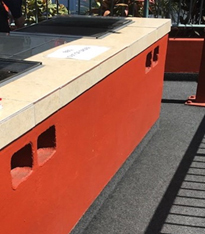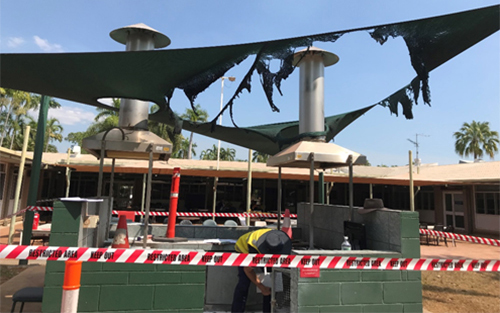Gas explosion risk from built-in LP gas barbecues
The purpose of this Safety Alert is to highlight to the gas explosion risk of poorly designed built-in liquefied petroleum gas (LP gas) barbecues that do not have adequate ventilation.
Background
Two gas explosions have occurred within the past 18 months involving built-in barbecues that have caused injuries to either the operator or nearby bystanders.
In the first incident, a young guest at a holiday apartment received burns when a family member attempted to start a gas barbecue, igniting the LP gas that had built up in the compartment underneath.
In the second incident, a worker using the barbeque facility at his workplace accommodation received burns to approximately 30% of his body after LP gas ignited when the worker started the barbecue.
Possible contributing factors
- LP gas is heavier than air, and gas leaking from a bottle will stay low to the ground and accumulate in an enclosed area if there is poor ventilation.
- In both incidents, the built-in barbecues were housed in poorly designed compartments with inadequate ventilation around the barbeque appliance, gas cylinder and associated regulator and piping.
- In incident 1, the gas bottles were stored in an enclosed compartment under the barbeque appliance, with the ventilation points built near the top of the compartment. LP gas had leaked and accumulated in the compartment.
- In incident 2, the barbeque facility was enclosed by a 1 metre high brick wall, with exception of a small entry way. LP gas had leaked and accumulated in the barbeque area because of the brick wall.
- The operators in both incidents did not check for gas leaks before starting (igniting) the barbeques.


Action required
- Facility managers and commercial property owners with built-in LP gas barbecue facilities should immediately check their manufacturer’s built-in housing design requirements to see if ventilation, installation and operational requirements have been met.
- Gas barbecues that have not been designed by the manufacturer to be installed as a built-in facility should not be used until checked by a licensed NT gasfitter. Contact NT WorkSafe on
1800 019 115 for further information.
Before installing a built in barbecue
- Make sure the barbecue has been designed for built-in installation and make sure manufacturer’s built-in housing design requirements have been followed.
- Always use a Licensed NT Gasfitter to install and maintain any gas appliance.
- Ensure the area for the barbecue facility has adequate fresh air and flow through ventilation.
- Do not obstruct the flow through ventilation of a built in LP gas barbecue facility with walls, fences, screens or other barriers.
- Do not store any LP gas cylinders or chemicals or flammable products near or under the built-in gas barbecue.
- Do not transport gas cylinders in an enclosed vehicle, unless the vehicle is fitted with a gas cabinet.
- Place signs in the barbecue facility instructing barbecue users to check that all hose connections are secure (if appropriate) and there is no smell of gas before starting the barbecue.
Further information
For further information, please refer to the following:
Safety Alert
- Storing gas cylinders in vehicles
- Safe installation and operating of inbuilt BBQs (QLD Department of Natural Resources and Mines)
Disclaimer
This Safety Alert contains safety information following inquires made by NT WorkSafe about an incident or unsafe practice. The information contained in this Alert does not necessarily include the outcome of NT WorkSafe’s action with respect to an incident. NT WorkSafe does not warrant the information in this Alert is complete or up-to-date and does not accept any liability for the information in this report or as to its use.